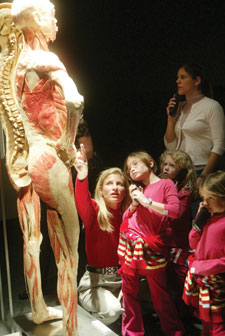 Fall 2007
Fall 2007|
Above, Transpara, the Talking Glass Lady, as she appeared in a 1970s animated booklet for children, The Mysterious Universe, Noted. Below, a family gets an up-close view of the real deal in BODIES … The Exhibition.
Transpara, the Talking Glass Lady, who was over 8 feet tall and like other such plastic models of the female body in science centers and health classes across the country, was electronically empowered to explain anatomy to generations of school children in short sound bites. As she did, the organs she referenced would light up, often to the excitement of her audience. (What become known as Transparent Anatomical Mannikins were teaching tools for millions of American school kids but also became a pop culture image when one graced grunge band Nirvana’s 1993 In Utero album cover.) “There were two prerecorded versions of the presentation,” notes Baillie, the chief program officer for Carnegie Science Center. “One was a general demonstration for the public; the second was a special demonstration designed for children.” He even recalls when the reel-to-reel recording tape was upgraded to cassette. “That probably dates me, not just the technology,” jokes Baillie. Nearly two decades later, Baillie is again prepping for a new batch of school children ready to learn about how their bodies work and why it’s important that they take an active role in their care. But this time, he’s armed with the real deal. “Bringing kids and the general public up close to the real thing, that’s what we always try to do, whether it’s looking at a rock from the surface of Mars or teaching about the human body,” says Baillie, lauding the October 8 arrival of BODIES … The Exhibition to the Science Center. Rather than rely on models, the exhibition includes 15 real preserved human bodies and more than 200 additional organs and partial specimens to educate people about their bodies . “There’s a hands-on component,” adds Baillie. “Visitors can literally hold a preserved human brain, lung, kidney, and liver as they exit the exhibition. Kids can actually feel how heavy the brain is; they can see what effect smoking has on the lungs. There’s no better way to teach about the body.” Instead of simulating the mechanics behind everyday physical activities, as was highlighted in BodyTech, the Science Center’s first body-related traveling exhibit in 1991, BODIES shows a real human body with its layers of muscles in action, hitting a tennis ball, or simply walking. “It really doesn’t get any better than that when you’re trying to understand what sets a body into motion,” notes Baillie. Transpara, state of the art in her time, was the earliest example of how Buhl Planetarium and today’s Carnegie Science Center have kept up with the technological times in a quest to bring science alive for kids and adults. In 2000, after the Science Center built its popular Zap! Surgery Beyond the Cutting Edge exhibit, it became the only traveling display in the world to detail the trend toward less invasive surgery and showcase complex technologies and the science behind them through interactive experiences. After six years on the road, a portion of Zap! Surgery is back home at the Science Center, examining the scientific principles behind several surgical technologies: endoscopes, lasers, ultrasound, cryosurgery, and the Gamma Knife. It’s a perfect partner for BODIES. Visitors will be able to view real human bodies, some of which are diseased, and then explore how the power of electromagnetic waves, sound waves, and lasers are harnessed by modern medical technology to then help heal the body—destroying tumors, breaking up kidney stones, and even correcting vision. It’s body language for healthy living.
|
Inside Out · 100 Years Ago · Art on a Grand Scale · The Real Deal · Hidden Treasure · Adding More Andy · Giant Steps Toward Building the Future · Director's Note · NewsWorthy · Now Showing · Face Time: Ron Wertz · About Town: Summer Sleuthing · First Person: Tracing the Making of a Collection · Artistic License: Dissecting Art · Science & Nature: Mind Games · Another Look: The Warhol's Film & Video Collection
 |
Copyright © 2017 CARNEGIE Magazine. All rights reserved. |


 Long-time science educator Ron Baillie remembers the many times he rolled out the life-size, transparent plastic model of a woman onto the stage of the Little Science Theater at Pittsburgh’s Buhl Planetarium and Institute of Popular Science. Before a packed audience of school children, he’d press a button and set into motion a 15-minute, pre-recorded presentation highlighting the purpose and importance of the body’s organs.
Long-time science educator Ron Baillie remembers the many times he rolled out the life-size, transparent plastic model of a woman onto the stage of the Little Science Theater at Pittsburgh’s Buhl Planetarium and Institute of Popular Science. Before a packed audience of school children, he’d press a button and set into motion a 15-minute, pre-recorded presentation highlighting the purpose and importance of the body’s organs.